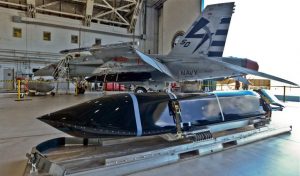The Japanese Ministry of Defense (MoD) has confirmed its intention to acquire the Lockheed Martin AGM-158C Long Range Anti-Ship Missile (LRASM) and the AGM-158B Joint Air-to-Surface Standoff Missile – Extended Range (JASSM-ER) for the Japan Air Self-Defense Force’s (JASDF’s) fleet of F-15J Eagle multirole fighter aircraft.
According to a MoD official speaking to IHS Jane’s on January 27, Japan intends to procure the new weapons systems “as soon as possible.” The requirement for a “stand-off defense capability” was outlined in Japan’s Mid-Term Defense Program, which was approved in December 2018.
The LRASM is a next-generation, precision-guided anti-ship missile with standoff capabilities, designed to detect and destroy specific targets within groups of surface warships in electronic warfare environments.
The weapon is a derivative of the JASSM-ER, a long-range cruise missile with an estimated range of up 1,000 kilometers (620 miles).
As I explained previously:
The LRASM began as a joint research project by the Defense Advanced Research Projects Agency (DARPA) and the U.S. Navy in 2009. The aim of the LRASM project was to deliver a new generation of anti-ship missiles with standoff capabilities — in other words, missiles with extended range, which would enable ships and aircraft to launch the weapon without being exposed to enemy counter fire. According to Lockheed Martin, the subsonic LRASM has an estimated range of over 320 kilometers and is fitted with a 450-kilogram penetrator and blast fragmentation warhead.
Japan is also in the process of equipping its fleet of Lockheed Martin F-35 Lightning II Joint Strike Fighters with the next-generation, long-range, precision-guided Joint Strike Missile (JSM).
The JSM, co-developed by U.S. defense firm Raytheon and Norwegian defense contractor Kongsberg Defense & Aerospace, is a fifth-generation stand-off, long-range sea- and land-target cruise missile designed to fit inside the F-35’s weapons bay. Each F-35 can be armed with up to two JSMs internally. The missile’s operational range is reportedly about 500 kilometers. Both the F-35A and B variants can be armed with the JSM.
The JSM has been designed for medium-range anti-ship and land attack missions and can “take on high value, heavily defended targets,” according to Raytheon. Initial operational capability of the JSM is expected in 2021 with full-operational capability to be reached in 2025.
Japan officially announced in 2017 that it would procure the JSM. The Japanese government awarded a contract to Kongsberg Defense & Aerospace for the procurement of an undisclosed number of JSMs in March 2019. A $49 million follow-on contract was signed in November 2019. Last year’s Japanese defense budget allocated around $71 million to procure the missiles.

































